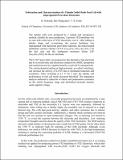Files in this item
Fabrication and characterization of a tubular solid oxide fuel cell with impregnated perovskite electrodes
Item metadata
| dc.contributor.author | Nowicki, Kamil Maciej | |
| dc.contributor.author | Wang, Mei | |
| dc.contributor.author | Irvine, John Thomas Sirr | |
| dc.date.accessioned | 2021-09-24T15:30:12Z | |
| dc.date.available | 2021-09-24T15:30:12Z | |
| dc.date.issued | 2021-07-18 | |
| dc.identifier.citation | Nowicki , K M , Wang , M & Irvine , J T S 2021 , ' Fabrication and characterization of a tubular solid oxide fuel cell with impregnated perovskite electrodes ' , ECS Transactions , vol. 103 , no. 1 , pp. 93-103 . https://doi.org/10.1149/10301.0093ecst | en |
| dc.identifier.issn | 1938-5862 | |
| dc.identifier.other | PURE: 275761628 | |
| dc.identifier.other | PURE UUID: f1f69347-20fe-4f32-ad9d-12ff882701ce | |
| dc.identifier.other | RIS: urn:10B096DEA2772C16010F33CE710D9F43 | |
| dc.identifier.other | Scopus: 85111682649 | |
| dc.identifier.other | ORCID: /0000-0002-8394-3359/work/99804096 | |
| dc.identifier.uri | https://hdl.handle.net/10023/24023 | |
| dc.description | The authors would like to acknowledge the EPSRC and the University of St Andrews for funding this work. | en |
| dc.description.abstract | The tubular cells were produced by a simple and inexpensive method, suitable for mass production. A porous YSZ backbone was co-cast with a thin layer of YSZ electrolyte over it. After rolling in tubular shape and co-sintering, the porous backbone was impregnated with functional perovskite materials, the nickel doped lanthanum calcium titanate LCNT (La0.43Ca0.37Ni0.06Ti0.94O3- γ) for the fuel side and the lanthanum strontium ferrite LSF (La0.8Sr0.2FeO3) for the air electrode. The LCNT perovskite was proposed as the alternative fuel electrode due to its mixed ionic and electronic conductivity (MIEC) properties and catalytical activity supplemented by exsolved Ni nanoparticles. The electrochemical poling at high potential, so-called 'switching', can increase the activity of LCNT due to facilitated reduction and exsolution. After switching at 2.1 V for 2 min, the tubular cell performance in fuel cell mode increased threefold. The impedance analysis indicated a reduction of ohmic and polarisation resistance on the whole frequency range and facilitated electrode kinetics under applied voltage. | |
| dc.format.extent | 11 | |
| dc.language.iso | eng | |
| dc.relation.ispartof | ECS Transactions | en |
| dc.rights | Copyright © 2021 ECS - The Electrochemical Society. This work has been made available online in accordance with publisher policies or with permission. Permission for further reuse of this content should be sought from the publisher or the rights holder. This is the author created accepted manuscript following peer review and may differ slightly from the final published version. The final published version of this work is available at https://doi.org/10.1149/10301.0093ecst | en |
| dc.subject | QD Chemistry | en |
| dc.subject | NDAS | en |
| dc.subject | AC | en |
| dc.subject.lcc | QD | en |
| dc.title | Fabrication and characterization of a tubular solid oxide fuel cell with impregnated perovskite electrodes | en |
| dc.type | Journal article | en |
| dc.description.version | Postprint | en |
| dc.contributor.institution | University of St Andrews. School of Chemistry | en |
| dc.contributor.institution | University of St Andrews. Centre for Energy Ethics | en |
| dc.contributor.institution | University of St Andrews. Centre for Designer Quantum Materials | en |
| dc.contributor.institution | University of St Andrews. EaSTCHEM | en |
| dc.identifier.doi | https://doi.org/10.1149/10301.0093ecst | |
| dc.description.status | Peer reviewed | en |
This item appears in the following Collection(s)
Items in the St Andrews Research Repository are protected by copyright, with all rights reserved, unless otherwise indicated.

